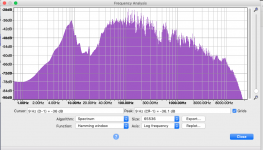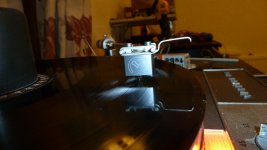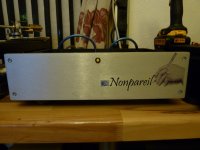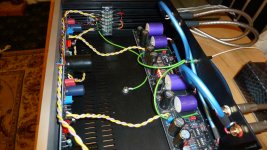I'm reluctant to mess with azimuth but the Jelco headshell does allow for it and included an Allen key.
A jfet has essentially a multi mega-ohm input impedance, correct?
Azimuth you may roughly check on a mirror surface. For more it takes test tracks and scope. BTW what is your arm + cart Fs on FFT?
Yes that's correct, a JFET has very high input impedance. Because it has very low gate current value (1pA or so) nowhere near a bipolar transistor's base current value.
There is a catch though, above a drain to source voltage threshold it starts losing input impedance as more and more gate leakage current forms. Behavior depending on type. In UFSP this parameter has been taken into consideration for proper voltage bias right from the start with its ancestors.
Cartridge loading should have very little influence on the input other than maybe amplitude of the incoming signal? I've read that loading should have little effect on an MC cartridge frequency response, is this true? I noticed that Benz lists loading from 500 - 47K, seems like a huge range.
No it does not influence an MC cart's audio band frequency response considerably. It affects the electrical damping of the whole system.
Including the cart and the phono and everything in between. There are ultrasonic resonances mainly electrical but mechanical too that in combination with gain selection, overload margin, RFI sensitivity, can give nuisance early on the loading values ladder or be more tolerable.
For example, you may find 100 Ohm a must with a 70s-80s Japanese integrated MC phono for a certain cart on a certain turntable but the same rig may sing better at 360 Ohm on UFSP. Because of their different circuit principles and stability. So its a matter of combined factors.
That is mainly why we read about so much different recommended load values from different owners of one same cart.
A tell tale sign you are already higher in load value than you should is ticks and pops begin to appear upfront and louder.
I have a digital stylus scale and set the VTF at 1.8g.
9 Hz is good. Indicates no problems with moving mass compatibility on your 1200 GR. But increase your VTF from 1.8g to 1.9g then to 2g and see if it takes more record warp into stride. The Benz Ruby 2 has 1.8-2.2g VTF span and you are on the light side. Leave it where it tracks and sounds best.
Good catch, I had forgot to go back and optimize VTF. I decided to do a bunch of tweaking this morning and ended up at 1.9g, reduced the anti-skate to 1, raised the VTA by 1mm at the pivot, made some very small (tenths of a degree) azimuth adjustments and switched to 560 ohm cartridge loading. I used a two-tone (400 Hz and 4K at -12dB) test track at 14.3 cm/sec on the Shure TTR-102 and captured it in Audacity. The idea was to get to equal looking waveforms which I think should indicate the best tracking, I could see subtle waveform variations as I changed things. The sound is terrific, it's like things snapped into critical focus. The attachment shows one channel inverted and the mono sum on the bottom. In doing a FFT on the mono difference the 400Hz signal is -36.9dB which seems to correlate with the cartridge channel seperation spec of >35dB so I think things are good but I'm still learning the on the Salas Ultra vinyl adventure. I'm very thankful for such a good guide!
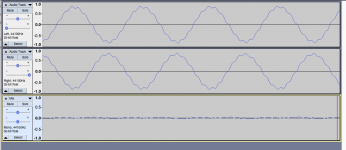
I went back and looked closely at the resonance and it is closer to 8.5Hz, seems ok but I know it's probably a little low.

I went back and looked closely at the resonance and it is closer to 8.5Hz, seems ok but I know it's probably a little low.
Last edited:
ended up at 1.9g, reduced the anti-skate to 1
Antiskating is not straightforward to perfectly set against VTF just on dial agreement, different stylus profiles slide differently in a modulated groove for one. I had a Dual CS 505 budget turntable in the early 80s. Its antiskating dial had a scale for elliptical and another scale for spherical. So I knew that already. And who knows about line contact or what other mechanical details may affect such micro forces when between different carts and arms combinations.
An externally hosted image should be here but it was not working when we last tested it.
Salas thank you for the guidance and kind words. The Dual anti-skate is really interesting and it explains a lot why it's an individual situation variable. When I first started back into vinyl I thought "great now I can capture a bunch on digital and have it everywhere" but there is something visceral in just enjoying vinyl. My A/D is a Tascam UH-7000 so I will pick a few tracks to post. I'm really curious now how much more there is with an even better turntable - maybe I can meet 6L6 and get to hear one of his SP-10s and a great arm. I'm also looking forward to the next GB, I want to build another UFSP and play around with the C3/C4 caps.
Dedicated Tascam A/D interface is nice. I tried recording through DCG3 to a Zoom H2n line in once and when I played back the file it was a disappointment vs what I was hearing on the headphones the first time around.
The SP-10 with a great arm if you will listen to you will get hooked and you will want one. The 1200GR rotates fine already but its the better arms freedom of choice, and then its the SP-10 itself which is battle cruiser on a choice plinth which can be massive.
The SP-10 with a great arm if you will listen to you will get hooked and you will want one. The 1200GR rotates fine already but its the better arms freedom of choice, and then its the SP-10 itself which is battle cruiser on a choice plinth which can be massive.
but there is something visceral in just enjoying vinyl
Living Stereo the marketing guys once called that feeling
Not only the addictive hands on experience with records and turntables, but its mono compatible mid/side mastering mix* same in principle as FM stereo, should be expected to noticeably contribute in the distinctive vinyl sound character. Lots of post production decisions and gear there** In addition to its other production steps idiosyncrasies from lacquer stage to home replay.
*Also called sum & difference, expressed as lateral & vertical modulation in the groove. See: How a Stereo Record Cutting Head Works
**Sculpting Sound: The Art of Vinyl Mastering
I am building up my UFSP and have this (first) problem:
I want to measure Vf of my LEDs (bought 50 pieces, to have enough to choose from).
Whem I measure with a DCA75 I measure something between 1.795V to 1.823V
With these values I cannot build up 3 LEDs for 5,8V or 4 LEDs for 7.75V
DCA75 measures at 5 mA current. Should I measure at a different current? Is this my problem? I have also a lab voltage supply and Keithley 195 here to deliver accurate results...
Thanks in advance,
Ulf
I want to measure Vf of my LEDs (bought 50 pieces, to have enough to choose from).
Whem I measure with a DCA75 I measure something between 1.795V to 1.823V
With these values I cannot build up 3 LEDs for 5,8V or 4 LEDs for 7.75V
DCA75 measures at 5 mA current. Should I measure at a different current? Is this my problem? I have also a lab voltage supply and Keithley 195 here to deliver accurate results...
Thanks in advance,
Ulf
Hello Ulf
Those LEDS in the UFSP BOM are different VF and different quality than the generics in the FSP prototype. More consistent for VF by sample. Go for totals of 7.2V at 5mA regarding the quad, 5V at 2mA regarding the triplet. The former are reaching high enough for the purpose, the latter serve a different function in the 1.3S shunt PSU than those in the previous shunt PSU.
Those LEDS in the UFSP BOM are different VF and different quality than the generics in the FSP prototype. More consistent for VF by sample. Go for totals of 7.2V at 5mA regarding the quad, 5V at 2mA regarding the triplet. The former are reaching high enough for the purpose, the latter serve a different function in the 1.3S shunt PSU than those in the previous shunt PSU.
RIAA
It's good to read different opinion and I did built the MC-MM preamp designed by Douglas Self and I'm wordless... just amazed! But now I have on hand freshly press PCB that has the same nice circuit but with onboard the Devinyliser of the same author. My point is keep a nice high supply voltage, use good capacitors, Vishay spare excellent polyester and polystyrene not to expensive. I did use the Supercap on my Self precision preamp but my MC-MM preamp isn't using them. I also ran a nice frequency response of the MC-MM preamp with a N4L equipment and the RIAA curve is so linear, no bump at all....! Be careful on believing that fancy caps will give you more. Make sure the response on real measurement equipment will give more more, not just audio ghost earing..... also remember to keep the supply outside the box. You bring DC voltage and inside the box, more µF of filtering with voltage regulation! Just use nice XLR-3 for power inlet.
It's good to read different opinion and I did built the MC-MM preamp designed by Douglas Self and I'm wordless... just amazed! But now I have on hand freshly press PCB that has the same nice circuit but with onboard the Devinyliser of the same author. My point is keep a nice high supply voltage, use good capacitors, Vishay spare excellent polyester and polystyrene not to expensive. I did use the Supercap on my Self precision preamp but my MC-MM preamp isn't using them. I also ran a nice frequency response of the MC-MM preamp with a N4L equipment and the RIAA curve is so linear, no bump at all....! Be careful on believing that fancy caps will give you more. Make sure the response on real measurement equipment will give more more, not just audio ghost earing..... also remember to keep the supply outside the box. You bring DC voltage and inside the box, more µF of filtering with voltage regulation! Just use nice XLR-3 for power inlet.
Last edited:
Salas ultra FSP
Thanks for the info on R6, your eyes are better than mine
System as it stands:
Cart is a North west analogue low output MC with FGS tip.
The Pre is a 12 AU7,
12SN7 dual mono I put together some while ago.

TT is the ubiquitous 401 in a slate plinth with SME 12" (it's a modified 3009)

Tannoy 15" Gold in an Onken/Goodmans style cab. (excuse the gallon of paint )
)

KT88 PP Amp

And a couple of perhaps retired FSP's


Thanks,
Greg
Thanks for the info on R6, your eyes are better than mine
System as it stands:
Cart is a North west analogue low output MC with FGS tip.
The Pre is a 12 AU7,
12SN7 dual mono I put together some while ago.

TT is the ubiquitous 401 in a slate plinth with SME 12" (it's a modified 3009)

Tannoy 15" Gold in an Onken/Goodmans style cab. (excuse the gallon of paint

KT88 PP Amp

And a couple of perhaps retired FSP's


Thanks,
Greg
- Home
- Source & Line
- Analogue Source
- Simplistic NJFET RIAA
